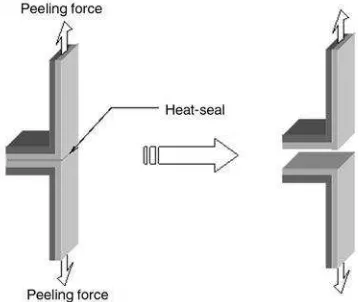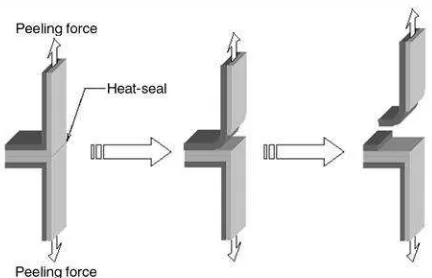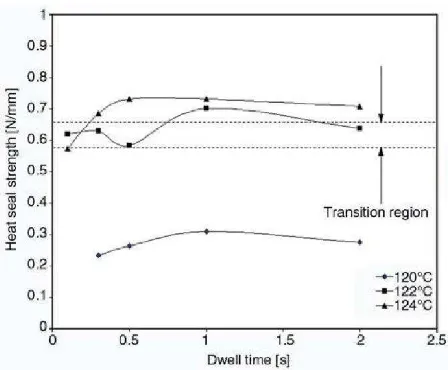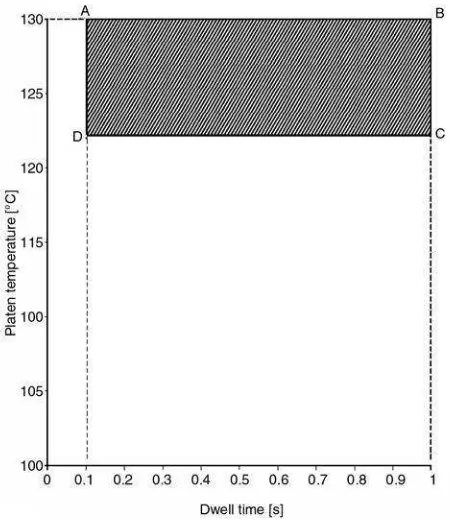Effect of bar sealing parameters on OPP/MCPP heat seal strength
C. S. Yuan
1, A. Hassan
2*1
Department of Thermal-Fluid, Faculty of Mechanical Engineering, Universiti Teknikal Melaka Malaysia, PO Box 1200, 75450 Ayer Keroh, Melaka, Malaysia
2
Department of Polymer Engineering, Universiti Teknologi Malaysia, Sekudai, Malaysia
ABSTRACT
The effect of bar sealing parameters on the heat seal strength of oriented polypropylene (OPP)/metallic cast polypropylene (MCPP) laminate film was investigated. Based on the results obtained from the parametric study, a bar seal-ing process window was developed. All points drop within the process window are combinations of platen temperature and dwell time that produce acceptable heat seal. Optimum combinations are indicated by the lower border of the window. The plateau initiation temperature,
Tpi of OPP/MCPP laminate film used in the present study occurred before the final melting temperature, Tmf of the sealant material. The highest achievable heat seal strength was at the plateau region, and the corre-sponding failure modes were delaminating, tearing or combine failure modes (delaminating and tearing). Minimum pres-sure level of 1.25 bars is necessary to bring the laminate interface into intimate contact in order to effect sealing.
Keywords: mechanical properties, heat sealing, OPP, MCPP, process window
1. Introduction
There are a number of heat sealing techniques which are used to produce flexible pouch or bag using the laminate films, i. e. bar sealers, rotary sealers, impulse sealer, bead sealers, hot knife or side weld sealers, etc. Compared to the others, bar sealing uses the least expensive equipment, hence, it is the most preferred technique [1].
Heat seal is formed by bonding together two poly-mer surfaces in the way that the surfaces are forced into intimate contact while they are in at least a par-tially molten state. Therefore, proper control of process parameters such as platen temperature, dwell time and pressure based on the characteristics of each laminate film is important to ensure that the pouch is leak-free and can withstand maximum loading during handlings. In packaging, the term ‘acceptable heat seal’ refers to the heat seal that when subjected to loading, will
*
Corresponding author, e-mail:
[email protected] © BME-PT and GTE
break at the laminate film instead of at the heat seal [2]. In other words, the strength of the heat seal is greater than the strength of the laminate film. This corresponds to the delaminating or tearing mode failures in the peel test specimens, where damage occurred on the laminate film rather than on the heat seal.
Several studies concerning effect of sealing param-eters on the performance of heat seal are found in the literature. Theller [3] was the pioneer researcher in this area when a precision laboratory heat sealer was made available in 1989. He studied the heat-sealability of plastic film in bar sealing applica-tions. He reported that the interfacial temperature and dwell time are the primary factors which con-trol the heat-seal strength. Pressure normal to the heat-seal surface had little effect above the level required to flatten the web for good contact. Meka and Stehling [4, 5] have conducted a series of
ies concerning heat sealing process. The effect of heat sealing process variables on seal properties of polyethylene films was quantitatively determined. They also estimated the required platen tempera-ture for the highest possible heat seal strength of a semicrystalline polymer with the given dwell time and interfacial temperature by finite element model. Further more, they reported that the heat seal strength is primarily controlled by sealing tem-perature and dwell time, rather than pressure. Heat seal strength versus platen temperature plot has been established in their study. Tetsuya et al. [6] had investigated the effect of heat sealing tempera-ture on the mechanical properties and morphology of oriented polypropylene (OPP)/cast polypropy-lene (CPP) laminate films. They reported that ten-sile strength of the seal was affected by the orienta-tion of the films. Whilst, Hashimoto et al. [7] had carried out investigation on the failure criteria of the heat sealed part of OPP/CPP heat seals made by impulse type heat sealing machine. They reported that heat seals were stronger in the transverse direc-tion as compared to the time to the process window of the laminate films are also studied in view of to provide a guideline to the bar sealing users when setting up their machine.
2. Experimental
2.1. Laminate films
The plastic film used in the present study was a commercial OPP/MCPP laminate film. The films were laminated through dry-bond process using a urethane adhesive. The thickness of OPP and MCPP films were 23 and 25 micrometers,
respec-tively. The final melting temperature, Tmf of the sealant layer (i. e. MCPP film) was 139.4°C as determined by differential scanning calorimeter at 10°C/min scan rate starting at 25 to 300°C under a helium purge gas.
2.2. Making of heat-seals
In the present study, the laminate film was sealed together in the sealant interface (i. e. MCPP film) to simulate fin seal formed in practice. The laminate films were first cut into 15 mm wide strips by
Lorentzen & Wettre cutter, made in Sweden. This cutter ensured that clean-cut edges are produced to prevent premature failures in T-peel test.
It was found that the strength of the heat seals and its failure modes are closely related. Similar to the results reported by previous researchers [3, 5], the heat seal failures of OPP/MCPP laminate film occurred in three stages, which are discussed as fol-lows:
When sealing was made at temperature substan-tially lower then the melting point of the sealant material (i. e. MCPP film), all samples failed in peeling mode failure (Figure 1). Heat seal strength of all samples reported under this failure mode was the lowest compared to the values reported under other failure modes.
In peeling mode failure, disentanglement of poly-mer molecules occurred which caused the bond to peel apart. This failure mode occurred when the strength of seal is below the strength of the lami-nate film.
The heat seal strength increases with platen temper-ature. This can be explained by the micro-Brown-ian movement of chain segments theory that thermal motion of the polymer increases with platen temperature as suggested by Stehling and Meka [5]. Consequently, the original zone of diffu-sion between the seal layer is deeper, and causes a greater peeling force required to separate the heat seal.
After the seal initiation temperature, the strength of the heat seal increased sharply before reaching the maximum value. In this range, samples failed in either one of the three failure modes: peeling, delaminating or tearing, or the combination of delaminating and tearing mode failures. This is the transition region in which failure mode was then changed from peeling to delaminating or tearing mode failure, or combination of these two failure modes.
Figure 2. Breaking of sealant layer at the edge of the
heat seal and simultaneous separation of laminate layers with heat seal intact
Delaminating mode failure (see Figure 2) involves a tensile break of the sealant layer, and followed by separation of the interlaminar bond. This occurred when the strength of heat seal exceeded the strength of the interlaminar bond. Consequently, separation occurred between the laminate layers (which is weaker) instead of at the heat seal (which is now stronger), and leaving the heat seal portion with the other laminate film intact. Hence, heat seal strength reported in delaminating mode failure was rela-tively higher than the heat seal strength reported under peeling mode failure.
On the other hand, tearing mode failure (see Fig-ure 3) may be attributed to the strengthening of the interlaminar bond at relatively high platen tempera-ture. Thus when the strength of the laminate struc-ture is lower than both the strength of the interlam-inar bond and the strength of the heat seal, failure occurred at the laminate structure during peeling test. Thus the strength of heat seal failed under this failure mode is the highest compared to values reported under other failure modes.
Figure 4. Combination of delaminating and tearing modes
The occurrence of combine failure mode (delami-nating and tearing) (see Figure 4) could be attrib-uted to the increased of interlaminar bond strength with platen temperature. It is conjectured that under marginal conditions, uneven strengthening of the interlaminar bond on the heat seal area occurred. Thus under the application of peel force, the lami-nate film first separated into monolayer structures at the peel line, and followed by tearing on the film where there existed weak points due to irregular tensile stress distribution attributed to the uneven strengthening of the interlaminar bond.
3.2. Heat sealing curve
The plot of heat seal strength versus platen temper-ature curves at 0.1 and 1 sec dwell time is as shown in Figure 5. From the plot, sealing began at temper-ature substantially lower than the melting point of the sealant material (i. e. MCPP). This temperature is
termed seal initiation temperature, Tsi where a measurable but low level of heat seal strength was
achieved [5]. After the Tsi, heat seal strength increased sharply with platen temperature. It was then leveled off at about 0.9 N/mm and formed a
Figure 5. Plot of heat seal strength versus platen
tempera-ture curves at 0.1 and 1 sec dwell time
plateau to the heat sealing curve. The platen tem-perature of 122°C at which the plateau region began is termed plateau initiation temperature, Tpi [5]. The highest achievable heat seal strength of OPP/MCPP laminate film was at the plateau region, and the corresponding failure modes were delaminating, tearing or combine failure modes. The trend that OPP/MCPP laminate film achieved its plateau seal strength before the sealant material completely melts, i. e. Tpi lower than Tmf, is in close agreement with the results reported by Tsujii et al. [6]. In their study, laminate film of similar group (i. e. OPP/CPP) was used to study the effect of heat sealing temperature on the properties of heat seal. The Tmf of CPP film (in their study) was 146.1°C while the Tpi was 120°C.
However, for laminate films using other sealant materials, e.g. LDPE, LLDPE, etc., the Tpi could be
equaled to, or higher than the Tmf of the respective sealant materials. For instance, Stehling and Meka [5]reported that the Tpi value correspond closely to the Tmf for all the unsupported polyolefins films investigated in their study. Whilst, Morris [9] reported that the Tpi of ionomer films begin after the Tmf value.
Hence, it can be deduced that laminate films using different sealant materials produces different Tpi– Tmf trends. Perhaps, more investigations are required to discern this dissimilarity.
3.3.Effect of platen temperature and dwell time
The effects of dwell time on heat seal strength at various platen temperature settings are shown in Figure 6. At the temperature substantially lower than the melting point of the sealant material, i. e. 120°C, no effects of dwell time on heat seal strength was detected. However, when the platen temperature was increased to 122°C, which is the plateau initiation temperature, the plateau seal strength was obtained at 0.7 sec. The same heat seal strength can be achieved at shorter dwell time of 0.2 sec, when the temperature was further increased to 124°C. Moreover, for each platen temperature setting, no effect of dwell time on heat seal strength was detected after achieving the plateau seal strength.
Distortion on the heat seal area appeared when the platen temperature was set at 138°C (which is at
Figure 6. Plot of heat seal strength versus dwell time
at various platen temperatures
one degree Celsius below the final melting point of the MCPP film), in both 0.1 and 1 sec dwell time cases. Thus the maximum platen temperature for this laminate structure should be lower than this value.
These results show that the platen temperature and dwell time are interrelated in obtaining the heat seal strength. However, platen temperature plays a more important role as compared to dwell time. It can be seen that, to effect sealing, the lowest activated temperature must be reached at the sealing inter-face. And in a heat sealing process, the interfacial temperature is primarily controlled by the platen temperature, while dwell time has to be sufficiently long to ensure that enough heat is transfer to the sealing interface in order to melt the sealant mate-rial.
Previous researchers have also confirmed that the main factor affecting heat seal strength is the platen temperature. The results of Theller [3], who looked at the effect of dwell time at constant platen tem-perature, indicated that the heat seal strength is a strong function of platen temperature and is not dependent on dwell time beyond 0.4 sec for low density polyethylene film sealed at 106 and 110°C. Meka and Stehling [4] also reported that heat seal strength depends primarily on plated temperature and secondary on dwell time. In addition, Morris [9] has confirmed the inverse proportionality rela-tion between platen temperature and dwell time, and has stated that they are influenced by film thickness according to heat transfer theorem.
The study of heat seal strength beyond 1 sec dwell time is only of theoretical interest. In practice, the
Figure 7. Plot of heat seal strength versus sealing pressure
setting of dwell time is below 1 sec as packaging machines are usually operated at very high speed in order to achieve the desired production rate.
3.4. Effect of platen pressure
The plot of heat seal strength versus plated pressure is as shown in Figure 7. No seal was produced at pressure of 1 bar. With slight increased of pressure (to 1.25 bar), sealing began, and the reported heat seal strength was indeed at the plateau level. At higher pressure setting after this point, no signifi-cant change of heat seal strength with pressure was detected. These results confirmed the results reported by previous researchers [4] that platen pressure has no measurable effect on heat seal strength.
Figure 8. Process window of OPP/MCPP film at 2 bars
setting for each respective dwell time is reveal in the lower border. Settings fall on this border are optimum combinations of platen temperature and dwell time, because no excessive temperature (energy) was used. The lower border fixed at 122°C indicates that acceptable heat seals can be obtained by setting the platen temperature at this value or above.
As may be seen, the lower border of the process window was constructed by a horizontal line. This indicates that the acceptable heat seal can be obtained at any dwell time settings within the effec-tive temperature range.
AB is the upper horizontal border. Distortion on the heat seal area begins at 138°C. Thus the upper hor-izontal border must be set lower than this value. In practice, heat seal can be made in a range of platen temperature settings, however, lower sealing tem-perature uses less energy, allow the package to be handled quicker, and have less potential effect on the contained product [10]. Therefore, the author recommended that the upper boundary be fixed at 130°C such that it provides some flexibility in choosing the platen temperature while ensuring that the setting did not go beyond the limit where seal distortion may result.
All points drop within the shaded area are combina-tions of platen temperature and dwell time that are capable to produce acceptable heat-seal. In many
cases, a form/fill/seal machine will be run at a designed speed, and therefore dwell time is virtu-ally a given. Hence the most suitable platen temper-ature setting can be found from the process window.
4. Conclusions
Bar sealing process window of OPP/MCPP lami-nate film was developed. The lower border of the window was fixed at 122°C. Acceptable heat seals can be obtained by setting the platen temperature at this value or above. The lower border of the process window is constructed by a horizontal line. Thus acceptable heat seal can be obtained at any dwell time settings within the effective sealing tempera-ture range (122 to 130°C). The upper boundary of the window was fixed at 130°C. Distortion on the heat seal area can be avoided by setting the platen temperature below this limit. Minimum pressure level of 1.25 bars is necessary to bring the laminate interface into intimate contact in order to affect sealing.
Three failure modes are identified for OPP/MCPP laminate film, namely the peeling, delaminating, and tearing modes. The laminate film may also fail in a combine failure mode (delaminating and tear-ing). Heat-seal strength achieved under tearing mode failure was the highest, and follow by strength achieved under delaminating mode failure, while the lowest value pertained to peeling mode failure.
References
[1]Falla D. J.: The use of ULDPE’s in pouch for packag
-ing flowable materials. in ‘ANTEC 94 conference pro-ceeding, San Francisco, USA’ vol III., 3141– 3146 (1994).
[2]Yuan C. S., Hassan A., Ghazali M. I. H., Ismail A. F.: Heat sealability of laminated Films with LLDPE and LDPE as the sealant materials in bar sealing applica-tion. Journal of Applied Polymer Science, 104, 3736– 3745 (2007).
[3]Theller H. W.: Heatsealability of flexible web materi-als in hot-bar sealing application. Journal of Plastic Film and Sheeting, 5, 66–93 (1989).
[4]Meka P., Stehling F. C.: Heat sealing of semicrys-talline polymer films. I. Calculation and measurement of interfacial temperatures: Effect of process variables on seal properties. Journal of Applied Polymer Sci-ence, 51, 89–103 (1994).
[5]Stehling F. C., Meka P.: Heat sealing of semicrys-talline polymer films. II. Effect of melting distribution on heat-sealing behavior of polyolefins. Journal of Applied Polymer Science, 51, 105–119 (1994).
[6]Tetsuya T., Ishiaku U. S., Mizoguchi M., Hamada H.: The effect of heat sealing temperature on the proper-ties of OPP/CPP heat seal. I. Mechanical properproper-ties. Journal of Applied Polymer Science, 97, 753–760 (2005).
[7]Hashimoto Y., Ishiaku U. S., Leong Y. W., Hamada H., Tsujii T.: Effect of heat-sealing temperature on the failure criteria of oriented polypropylene/cast poly-propylene heat seal. Polymer Engineering and Sci-ence, 46, 205–214 (2005).
[8]ASTM F88-85: Standard test methods for seal strength of flexible barrier materials (1985).
[9]Morris B. A.: Predicting the heat seal performance of ionomer films. Journal of Plastic Film and Sheeting,
18, 157–167 (2002).



